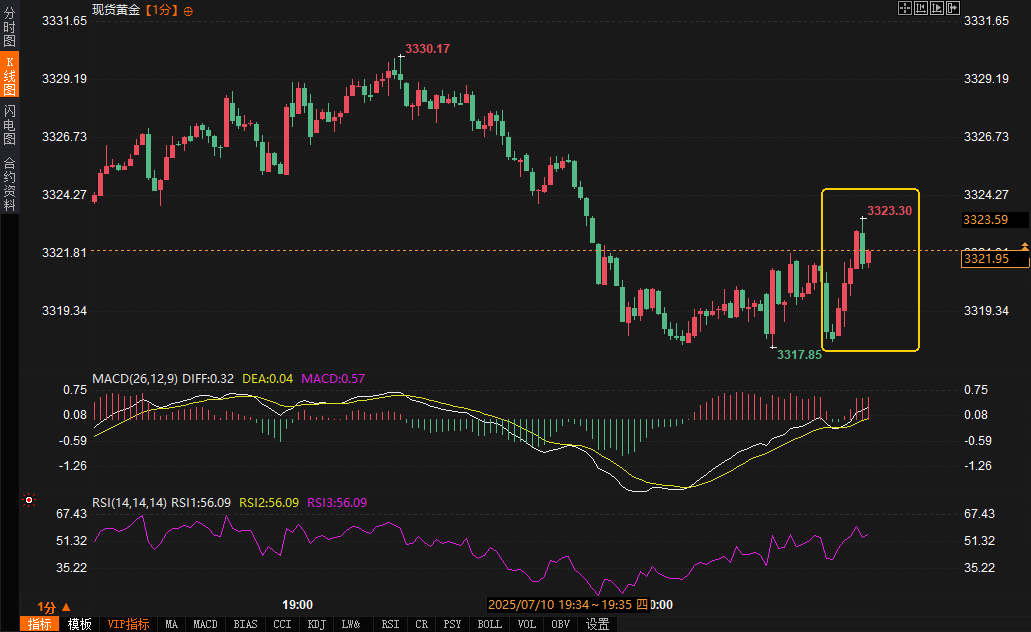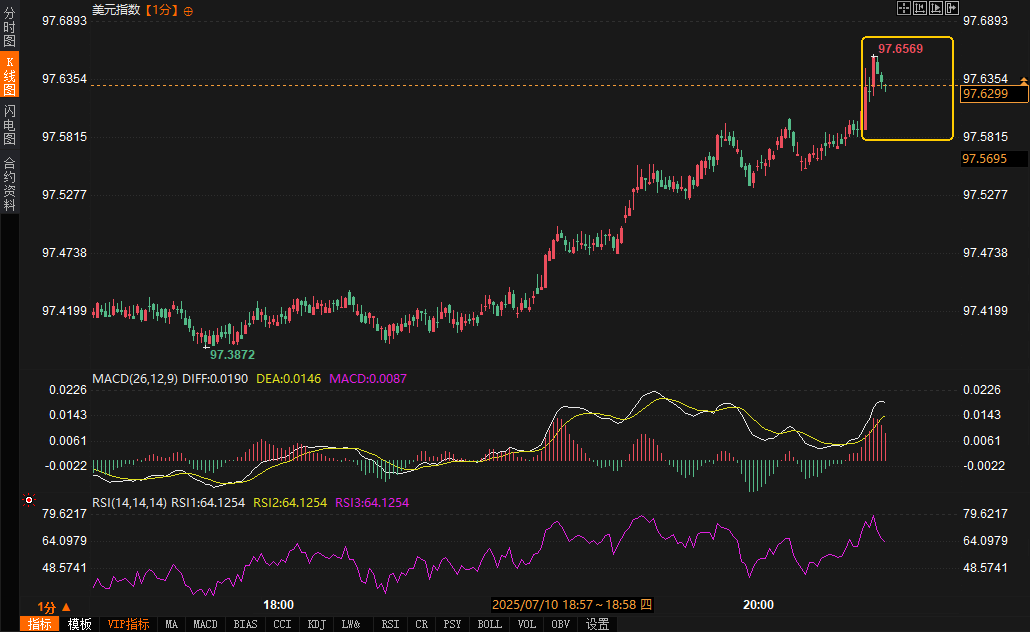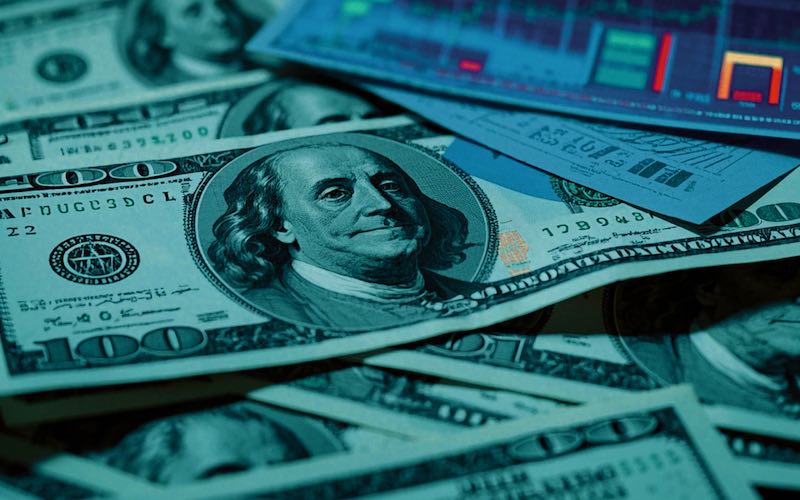227,000 initial claims set off the market! The US dollar squeezed 97.65, and gold "dodged" at 3323 before counterattacking
2025-07-10 20:54:18

After the data was released, the US dollar index rose by about 7 points in the short term, reaching a high of 97.6569, and the gold price rebounded quickly after a short-term decline. The following analyzes the significance and future trends of this data from the perspectives of immediate market reaction, the impact of the data on the Fed's interest rate cut expectations and market sentiment, and combined with the views of institutions and retail investors.
Immediate market reaction: The dollar strengthened and safe-haven assets came under pressure
After the data was released, financial markets reacted quickly. The US dollar index rose further above 97.50, reaching a high of 97.6569 and closing at 97.6450, showing the market's recognition of the resilience of the US labor market. US Treasury yields also rose, with the 10-year Treasury yield rising 1.4 basis points to 4.356%, and the two-year and ten-year Treasury yield curve remained positive at 48.4 basis points, further strengthening the market's buying sentiment for the US dollar.


At the same time, safe-haven assets were under pressure. Spot gold fell about $3 in the short term after the data was released, but quickly rebounded to $3,323.30 an ounce, indicating that the market's safe-haven demand for gold has not completely subsided. The U.S. stock market fell slightly, reflecting investors' complex emotions as they digested strong data and tariff uncertainties. An anonymous trader expected that initial claims might be higher than expected due to holiday fluctuations before the data was released, but quickly adjusted his views after the data was released, saying: "The initial claims data of 227,000 completely slapped market expectations in the face, and the short-term rise of the U.S. dollar was expected. The EUR/USD support level of 1.1680 is in jeopardy." Another agency pointed out: "The rise in Treasury yields and the strengthening of the U.S. dollar indicate that market expectations for a short-term rate cut by the Federal Reserve have further declined."
Compared with the market sentiment before the data was released, investors had a more pessimistic expectation for the initial claims data. Affected by holiday fluctuations and recent news of corporate layoffs, it was generally expected that the data might be close to or above 235,000. However, the strong performance of the actual data reversed this expectation, boosted short-term buying of the US dollar, and weakened the market's bets on a July rate cut. The CME FedWatch tool shows that the probability of a rate cut in July has dropped from about 10% before the data was released to 6.7%, while the probability of a 25 basis point rate cut in September remains at around 67.3%.
Impact on Fed rate cut expectations
The unexpected drop in initial claims provides new evidence of the resilience of the labor market, even though the June jobs report showed that the unemployment rate fell to 4.1% mainly due to a shrinking labor force, and the 147,000 new jobs were concentrated in a few industries. Federal Reserve Chairman Powell recently said that in the current low hiring and low firing environment, any increase in layoffs could quickly push up the unemployment rate. However, initial claims data show that layoff pressures have not yet emerged significantly, although nearly 100 US companies, including Microsoft and Intel, announced layoff plans this month. The number of continuing claims rose to 1.965 million, the highest since November 2021, indicating that it has become more difficult for the unemployed to find work, but the overall labor market is still seen as solid.
The Fed kept the policy rate unchanged at 4.25%-4.50% in its meeting last week, stressing that it would not easily cut interest rates before observing the impact of tariff policies on inflation. Well-known institutions pointed out that the strong initial claims data further reduced the possibility of a rate cut in July, and the market focus shifted to the September meeting. A senior analyst commented: "The initial claims data was lower than expected, and the continued claims were high but still within a controllable range. The Fed has no reason to rush to cut interest rates in the short term, and September may be a more realistic window." At the same time, Trump's tariff remarks continue to add uncertainty to the market, and some companies have slowed down recruitment due to unclear policies, which may pose potential pressure on the labor market in the coming months.
Before the data was released, market expectations for the Fed to cut interest rates had cooled due to the strong performance of the June employment report, and the further positive initial claims data reinforced this trend. In contrast, the high number of continued claims in May and June (up to 1.956 million) had caused market concerns about a cooling labor market, but the improvement in this data alleviated some of the pessimism. A retail trader said: "Although the number of continued claims is high, the decline in initial claims shows that companies are still gritting their teeth to retain employees. The Fed may continue to stay on the sidelines, and the dollar still has room to rise in the short term."
Market sentiment changes: a game between risk aversion and optimism
The strong performance of the initial jobless claims data boosted market confidence in the US economy in the short term, and the strength of the US dollar reflects investors' recognition of the resilience of the labor market. However, Trump's tariff remarks and the continued tensions between Russia and Ukraine continue to support risk aversion, as evidenced by the rapid rebound in gold prices. One agency pointed out after the data was released: "The initial jobless claims data boosted the US dollar, but the rebound in gold shows that market concerns about tariffs and geopolitical risks have not subsided." Another retail trader believes: "The US dollar index may test 98.00 after breaking through 97.65, but if the subsequent data is weak, the risk of a pullback cannot be ignored."
Compared with the cautious sentiment before the data was released, the market turned relatively optimistic after the data was released, the US dollar buying increased, and risk assets diverged. The decline in the stock market reflects investors' concerns about future uncertainties, while the rise in Treasury yields indicates the market's reassessment of economic resilience and inflation expectations. An institutional analyst concluded: "The unexpectedly positive initial claims data provided short-term support for the US dollar, but the high number of continued claims and uncertainty about tariff policies mean that market sentiment is still unstable and investors need to remain vigilant."
Future Trend Outlook
Looking ahead, the short-term trend of the US dollar index may continue to be supported by labor market data. If subsequent initial claims data remain low, the US dollar may further test the 98.00 resistance level, especially if Treasury yields continue to rise. However, the high number of continued claims and weak corporate hiring indicate that the labor market is not without hidden dangers, and any increase in layoff pressure may quickly change market sentiment. The Fed's policy path remains a key variable. Although expectations of a rate cut in September are dominant, more economic data (such as CPI and retail sales) are needed to confirm the trend of inflation and growth.
Tariff rhetoric and developments in the Russia-Ukraine situation will continue to inject uncertainty into the market, which may drive funds to rotate between safe-haven assets such as the US dollar and gold. The upside of the US dollar index depends on whether it can break through the psychological level of 98.00. Investors should pay close attention to next week's renewal data and the upcoming July non-farm payrolls report, which will provide more clues to the long-term trend of the labor market.
Overall, the unexpected decline in initial claims data provided short-term momentum for the US dollar, but market sentiment is still in a game between optimism and risk aversion. While paying attention to the performance of the data, traders need to be alert to the potential disturbance of macroeconomic policies and geopolitical risks to the market.
- Risk Warning and Disclaimer
- The market involves risk, and trading may not be suitable for all investors. This article is for reference only and does not constitute personal investment advice, nor does it take into account certain users’ specific investment objectives, financial situation, or other needs. Any investment decisions made based on this information are at your own risk.










